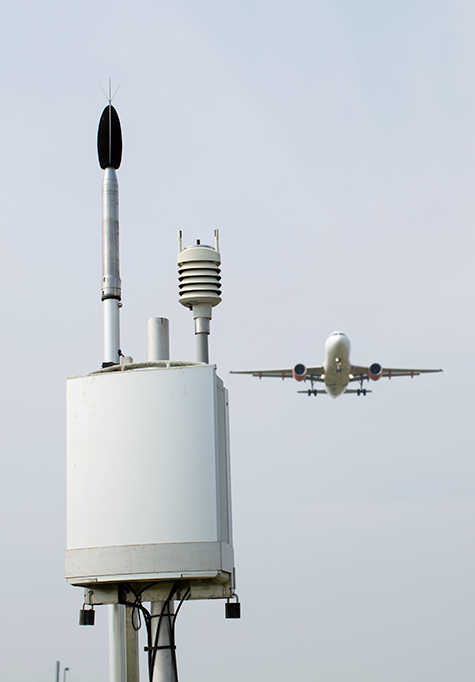Around five helicopters a day flew over Palm Cove because of the location of a reporting point. The investigation found that moving the reporting point over water was feasible from a safety and efficiency perspective and would be a noise improvement for Palm Cove. The change was implemented.
Investigation: Proposed night-time respite southern departure path
Airservices proposed a trial to change the flight path for some aircraft departing to the south off Runway 21 at night. The environmental assessment (based on noise modelling) indicated it would not deliver an overall noise improvement. To validate the modelled data used in the environmental assessment, in March and April 2016 Airservices conducted a six-week validation study. Noise monitors were installed at several points along the proposed flight path to obtain baseline noise readings, and then some aircraft were re-routed to use this flight path to collect actual noise level readings. This allowed a direct comparison between actual noise data collected and the modelling data that was used in the environmental assessment.
The study validated the modelling data used in the environmental assessment. As a result that flight path initiative will not be pursued further.
The Melbourne Noise and Flight Path Monitoring System (NFPMS)
We collect noise and operational data from five noise monitors (Environmental Monitoring Unit, EMU) around Melbourne Airport. Noise monitors are listed below according to their location.
Access monthly data on our Melbourne noise monitoring reports page.
BULLA (EMU 2)
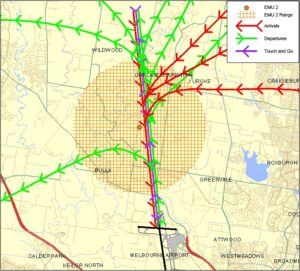
Captures arrivals to Melbourne Runway 16 and departures from Melbourne Runway 34.
Detects more events than the other noise monitor locations due to its proximity to the airport.
The pattern of aircraft noise events recorded reflects the seasonal trends in arrivals to Runway 16, with more events recorded in summer than in winter.
ESSENDON (EMU 4)
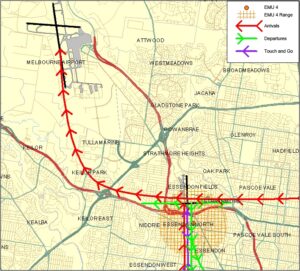
Captures arrivals to Melbourne Runway 34 and arrivals to Essendon Runway 35 and departures off Essendon Runway 17.
Seasonal fluctuations in the use of Runway 34 at Melbourne Airport are offset by the opposite fluctuations in the use of Runway 17 at Essendon Airport.
COOLAROO (EMU 6)
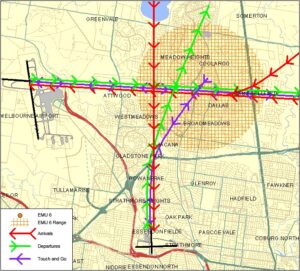
Captures arrivals to Melbourne Runway 27.
While the pattern of noise events recorded reflects the seasonal trend for arrivals to Runway 27 the correlation is not precise as there are some parts of the year where for noise abatement purposes, Runway 27 is used more for departures than for arrivals. Departures from Runway 27 do not fly over this monitor.
KEILOR DOWNS (EMU 9)
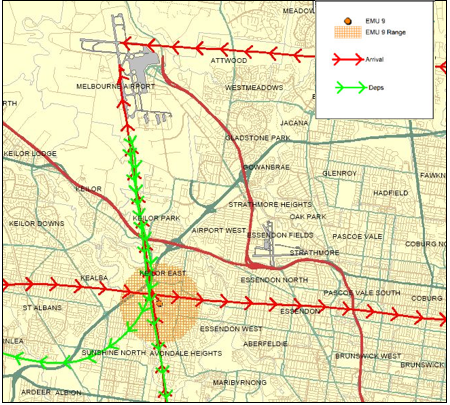
Captures arrivals to Melbourne Runway 34 and arrivals to Essendon Runway 35 and departures off Essendon Runway 17.
Seasonal fluctuations in the use of Runway 34 at Melbourne Airport are offset by the opposite fluctuations in the use of Runway 17 at Essendon Airport.
KEILOR EAST (EMU 3)
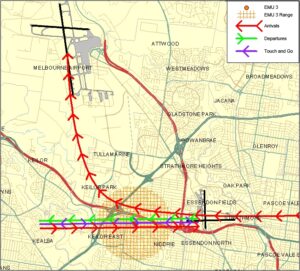
Captures arrivals to Melbourne Runway 34.
The pattern of aircraft noise events reflects the seasonal trend for arrivals to Runway 34, with more events recorded in winter than in summer.
THOMASTOWN (EMU 11)
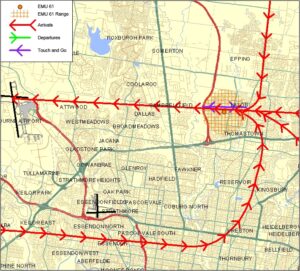
Captures arrivals to Melbourne Runway 27.
The pattern of aircraft noise events recorded reflects the seasonal trend for arrivals to Runway 27, with more events recorded in winter than in summer. As a result the trend for this monitor mirrors that of Coolaroo monitor.
Learn more about monitoring aircraft noise on the Airservices website.
Investigation: Preferred runway under the Noise Abatement Procedures
Perth Airport Noise Abatement Procedures are used by pilots and air traffic control to minimise the impact of aircraft noise on residential areas. The procedures nominate which runways and flight paths are preferred for arriving and departing aircraft. In May 2015 the procedures were amended to accommodate changes to the preferred runway system.
Airservices review of Perth Airport’s noise abatement procedures found the wording on runway preferences did not consistently match the operational requirement of managing the flow of aircraft to and from the airport (in the air and on the ground).
The old procedures specified that Runway 21 (arriving over Guildford) and Runway 24 (arriving over Greenmount) were equally preferred for arrivals and Runway 21 (departing over Queens Park) was the only runway preferred for departures. Arrivals to Runway 06 (over Redcliffe) and departures from Runway 24 (over Redcliffe) were least-preferred due to the close proximity of residential areas at the southern end of the cross runway.
The procedures now give equal preference to arrivals to Runway 21 (over Guildford), Runway 24 (over Greenmount) and Runway 03 (over Queens Park). For departures, equal preference is given to Runway 21 (over Queens Park), Runway 03 (over Guildford) and Runway 06 (over Greenmount). Arrivals to Runway 06 (over Redcliffe) and departures from Runway 24 (over Redcliffe) have been maintained as being least-preferred.
The Post Implementation Review of this change was completed in October 2016 after one year of operations.
Read the Post Implementation Review – Perth Preferred Runways
Read the Terms of Reference for the Post Implementation Review
Investigation: Late turns off Runway 15
Aircraft making late turns after departure from Runway 15 impacts on residents in the Esplanade area in Cairns. The investigation established that this was occurring more frequently than expected. Airservices wrote to the airlines to communicate the community concerns and ask for confirmation that they would comply with the requirements of the departure procedure at all times, unless there were critical reasons not to do so (ie emergency or weather). Subsequently community representatives on the Airport Environment Consultative Committee noted that they had seen a difference.
Investigation: Alternative helicopter route to/from airport and reef
In Cairns there is significant helicopter traffic to and from the reef. While helicopters usually track direct between the Cairns Airport helipad and the reef, at times helicopters are tracked over residents to the north of the airport resulting in concerns being raised by residents.
Discussions with air traffic control revealed that due to the helipad’s location to the west of the runway, at times there was conflict with arriving or departing fixed wing aircraft which prevented helicopters tracking directly to or from the helipad.
A possible noise improvement was identified that, where it was not possible to provide direct tracking and where it is operationally feasible, helicopters be instructed by air traffic control to track via the inlets and not over the residential areas. This would mean that track miles would be increased on these occasions. Further discussions with air traffic control will be undertaken.
Parafield Airport Consultative Committee
Federally-leased airports (excluding Mt. Isa and Tennant Creek) have established Community Aviation Consultation Groups (CACGs), which provide an effective avenue for local community engagement on airport planning and operations, including aircraft noise. The Department for Infrastructure, Transport, Regional Development and Communications provides guidelines for CACGs.
Non federally-leased airports may also choose to establish CACGs or community forums.
CACG membership depends on the characteristics of the airport and any local issues of community concern however, generally includes:
- airport management
- aircraft operators
- community organisations or representatives
- representatives from state, territory or local government bodies
- local tourism and business groups.
Airservices does not formally belong to CACGs, but is invited to attend to provide relevant information and assist in discussions. We engage with CACGs on flight path and airspace changes, as well as technical reviews, such as noise monitoring and noise abatement procedures.
Find out more information on the Parafield Airport Consultative Committee webpage.
Investigation: Runway 15 departure turns
The Airport Environmental Consultative Committee requested an investigation into concerns that some airlines were not performing the required turn correctly after departure from Runway 15. Aircraft are required to begin their turns at the earlier of the end of the runway or when they reach 400 feet. Non-compliance is followed up by air traffic control.
Data on 4178 jet departures from July to November 2016 was analysed. The investigation found that variations in the turns were not confined to any one airline, and were the result of the differing turn performance of different aircraft types. While aircraft were beginning their turns at the correct point in flight, some aircraft types would take longer to complete the turn than others, creating a wider arc.
Investigation: Runway 15 departures non-compliance
In April 2018 the Noise Complaints and Information Service conducted an investigation to review the concerns raised in complaints from community members and the Airport Environmental Consultative Committee about non-compliance with the Runway 15 departure procedure.
Adelaide Airport Consultative Committee
Federally-leased airports (excluding Mt. Isa and Tennant Creek) have established Community Aviation Consultation Groups (CACGs), which provide an effective avenue for local community engagement on airport planning and operations, including aircraft noise. The Department for Infrastructure, Transport, Regional Development and Communications provides guidelines for CACGs.
Non federally-leased airports may also choose to establish CACGs or community forums.
CACG membership depends on the characteristics of the airport and any local issues of community concern however, generally includes:
- airport management
- aircraft operators
- community organisations or representatives
- representatives from state, territory or local government bodies
- local tourism and business groups.
Airservices does not formally belong to CACGs, but is invited to attend to provide relevant information and assist in discussions. We engage with CACGs on flight path and airspace changes, as well as technical reviews, such as noise monitoring and noise abatement procedures.
Find out more information on the Adelaide Airport Community Aviation Consultation Group webpage.


